Intel's new Atom Microarchitecture: The Tremont Core in Lakefield
by Dr. Ian Cutress on October 24, 2019 1:30 PM EST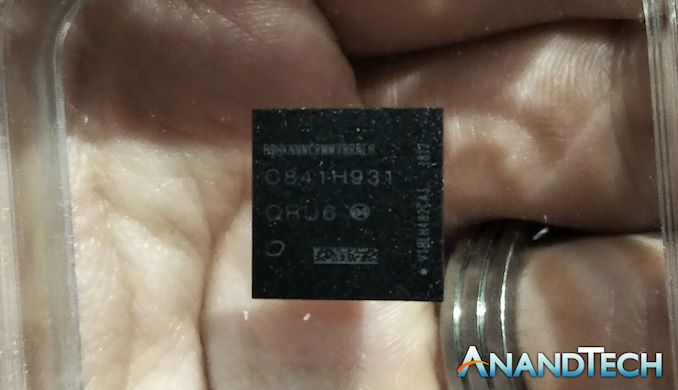
While Intel has been discussing a lot about its mainstream Core microarchitecture, it can become easy to forget that its lower power Atom designs are still prevalent in many commercial verticals. Last year at Intel’s Architecture Summit, the company unveiled an extended roadmap showing the next three generations of Atom following Goldmont Plus: Tremont, Gracemont, and ‘Future Mont’. Tremont is set to be launched this year, coming first in a low powered hybrid x86 design called Lakefield for notebooks, and using a new stacking technology called Foveros built on 10+ nm. At the Linley Processor Conference today, Intel unveiled more about the microarchitecture behind Tremont.
For the sake of clarity, a pre-note on ‘Core’ vs ‘core’:
- ‘Core’ and ‘Atom’ are Intel’s two main x86 microarchitecture families
- A ‘core’ is a single designated CPU capable of processing instructions, and can be built by Intel with either ‘Core’ or ‘Atom’ microarchitectures
A Brief History of Atom
Intel’s lower powered Atom microarchitecture has been used for a variety of solutions: embedded platforms, networking, smartphones, tablets, netbooks, NAS devices, control hubs, and a wide array of things we don’t even know about. The positioning of Atom compared to Core was meant to be that Atom was the smaller core design, taking up less silicon die area and being lower performance, but ultimately lower power in a time where the Core microarchitecture was focused more towards high performance designs.
The last few generations of Atom are readily quantified: Silvermont based on 22nm was a big product for the company, which has evolved into Airmont, Goldmont, Goldmont Plus, and now Tremont.
| Intel's Atom History | ||||||
| AnandTech | Node | Smartphone | Tablet | Netbook Notebook |
Networking Server |
|
| Saltwell | 32nm | 2011 | Medfield Clover Trail+ |
Clover Trail | Cedar Trail | |
| Silvermont | 22nm | 2013 | Merrifield Moorefield |
Bay Trail-T | Bay Trail-M Bay Trail-D |
Rangeley Avoton |
| Airmont | 14nm | 2015 | 'Riverton' | Cherry Trail-T | Braswell | Denverton |
| Goldmont | 14nm | 2016 | 'Broxton' | Willow Trail Apollo Lake |
Apollo Lake | |
| Goldmont+ | 14nm | 2017 | Gemini Lake | |||
| Tremont | 10+ | 2019 | Lakefield | Lakefield | Snow Ridge | |
The Atom family lines get a little confusing with Intel playing in all these spaces. The Atom core within in given family is usually identical (L2 configuration might change), and because of the SoC in play, it might get a different name based on the market where it was headed. Intel scrapped the smartphone program back with Broxton in 2016, and the tablet type of SoC has also gone away. With Lakefield, combining Core and Atom, it could be used in Tablets again for 2019/2020, but we will see it in Notebooks with the Surface Pro Neo and in networking/embedded markets as Snow Ridge.
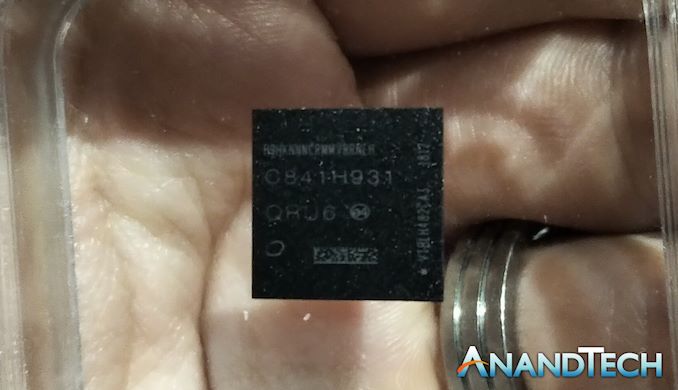
Lakefield - 12mm x 12mm, 2mW Standby Power
It is worth noting that as Intel expanded the scope of its Core microarchitecture, from 1.5W per core to 20W+ per core, it has kind of edged Atom more into niche products. Atom still had that super-low-power advantage, with a much smaller die area, but has also been super low performance with a quantifiable step-function below what Core can provide. With Tremont, Intel’s primary focus was bringing the single thread performance of the Atom design in parity to Core at the lower end of performance, with a sizeable overlap between the performance of a single Core design against a single Atom design. Intel published this graph to demonstrate what this looks like on early silicon:
Now, Intel’s Atom platforms haven’t had the greatest press over the last few years. Aside from providing some really nice notebooks around the $200 range on the consumer side, the enterprise side has been dealing with a clock degradation issue that ultimately leaves Atom systems built on C2000 processors unable to boot, which was bad news for embedded Atom systems designed to run for 10-20 years. Intel has since fixed that bug with a silicon update, but the point of that silicon was for it not to be touched for a generation.
With that aside, Intel is looking to revive its Atom fortunes with the new Tremont design, and looking forward to Gracemont and beyond. More performance, crossing over with Core, and with hardware built on Intel’s latest 10+ process, should afford a number of opportunities. Until we get our hands on the hardware, we’re going to examine the design.
Design Goals for Tremont
The odd quirk about CPU design is that for engineers that have been embedded in this space for 20 years, when they were taught about processor design, the main focus was all about performance. Little attention was paid to power. Fast forward to today, and power is the often talked about point when it comes to battery powered devices, and learning to design for both performance and power becomes an intense balancing act for all the engineers involved. We’ve spoken to companies that only allow performance enhancements if the power increase is at most equal in percentage, or perhaps a 2:1 ratio of performance/power. It’s a difficult pie to bake at any rate.
The interesting thing here in our briefing with Intel is that they specifically stated that Tremont was built with performance in mind, and the aim was for a sizeable uptick in the raw clock-for-clock throughput compared to the previous generation Atom, Goldmont Plus. Based on Intel’s own metrics, namely using SPEC, Intel is going to claim an average 30% iso-frequency performance uplift in core performance for Tremont over Goldmont Plus.
It’s worth noting here that this data is from an early Tremont design we were told, and should represent minimum uplifts. The graph is somewhat skewed at the top end with three of the SPEC tests getting 65%+ uplifts, and at the time of discussion, Intel did not have to hand exactly which tests these were (likely libquantum, lbm). We weren’t told how the code was compiled, however Intel did state that the same compiled binaries were used on both Tremont and Goldmont Plus. Intel didn’t state if they’re actually adjusting the clock of each core to match each other, or doing a performance per clock analysis using the frequency as a division factor. These results have to be taken at face value.
A 30% average jump in performance is a sizeable jump for any generation-to-generation cadence. Just taking it as-is feels premature: aside from microarchitectural advancements and a jump to 10nm, there has to be something at play here – either the power budget of Atom has ballooned, or the die area. With Intel explicitly out of the gate stating that their focusing on performance, a cynic is going to suggested that something else has paid that price, and to that end Intel wasn’t prepared to talk about power windows or die area, though they did point to the already announced Lakefield CPU, which has a 1 x Core + 4 x Tremont design and gets compared to 7 W CPUs.
Comparing 14nm Goldmont Plus (that’s standard 14nm, not 14+ or 14++) to a 10+ Tremont core is going to be difficult: the Tremont core has more in it to drive that performance, however what is not known is how much space was saved moving from 14nm to 10+ and if the extra parts make the core bigger or smaller overall. Needless to say, Tremont has more in it to drive that performance, which we’ll cover in the next few pages.



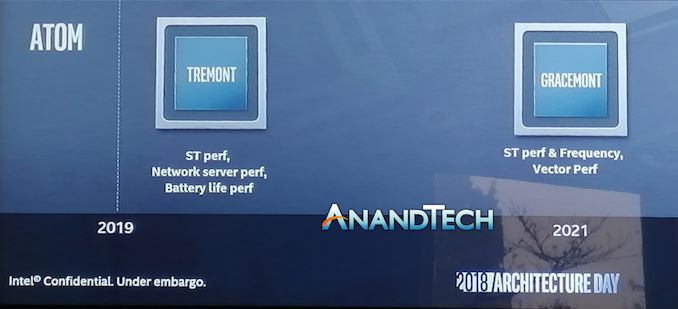
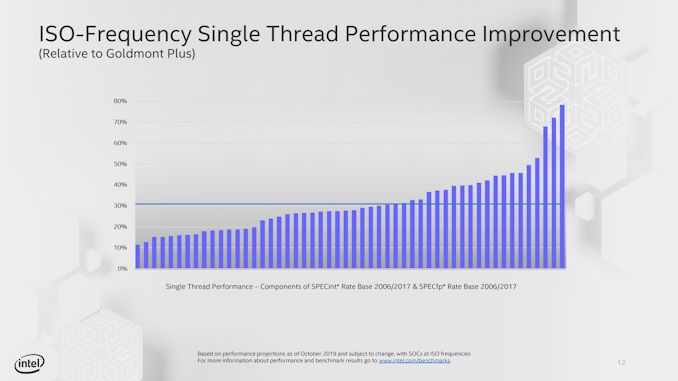
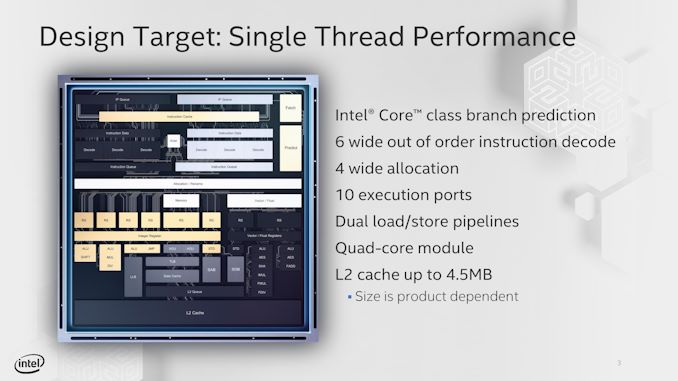








101 Comments
View All Comments
vladx - Friday, October 25, 2019 - link
Obviously Intel waited until it was left with no choice.Ratman6161 - Friday, October 25, 2019 - link
"Did Atom processors ever stop sucking?"Actually I don't believe they ever started sucking. As with many things, once OEM's decided they were for cheap systems, they built systems where everything else was cheap too. Atom was never designed for high performance and when you combined it in a laptop where everything in it was the cheapest the manufacturer could get...you got crap. I think within its niche it wasn't really half bad.
I've Got an Asus Zenbook S8 with an Atom Z3580 running Android 6 and it was actually pretty fast for an Android tablet of its day. It competed well with Samsung's tablets at that time and was a fraction of the cost ($249 on Amazon back then). I still use it and its still more than adequate for web surfing, email, Netflix, Amazon Prime video etc. Keep Atom where it belongs and don't set unreasonably high expectations for it and it doesn't suck.
mode_13h - Saturday, October 26, 2019 - link
I dunno... did x86 processors ever stop sucking?They do deliver good perf/W - better than Intel's big cores, but still not as good as ARM.
Korguz - Sunday, October 27, 2019 - link
" if they are not as good as arm " how so ??Namisecond - Friday, November 1, 2019 - link
Not as good perf/W but we are comparing ARM to x86 here.olde94 - Saturday, October 26, 2019 - link
that widely depends on your application. as far as i understand atoms are widely used in servers due to their power consumption, low heat output and focus on CPU performance compared to other mainstream cpu's. so yeah for some applications atoms are quite ok.olde94 - Saturday, October 26, 2019 - link
a system like this https://www.supermicro.com/products/system/3U/5039... is a single server rack with a total of 192 cores at less than 400W. and while it's atom cores i would like to have you realize that they run at 2.1ghz, wheres a system like a Gold CPU 6148 x2 is a 40 core @2.4ghz at above 300w. so while the xeon has better IPC we are talking about a 40c vs 192c system at a comparable power budget runing a frequency that is similar. so the xean need more then 4x better IPC to win here. once again there are a lot of features the atom does not support and the IPC surely is different, but atom is not "just" badCalista - Sunday, October 27, 2019 - link
Atom have come a really long way from its earliest versions. Try using something like a N270 and compare it to an X5-E8000. The former will be completely unusable, the later not really zippy but more than fast enough for most common workloads except gaming.yeeeeman - Sunday, March 15, 2020 - link
Silvermont based tablets that sold at 100 bucks were amazing value for money.You should stop sucking whatever you are sucking, because atom was quite good after silvermont launched.
ternnence - Thursday, October 24, 2019 - link
The two ALUs have one focused on fused additions (FADD), while the other focuses on fused multiplication and division (FMUL).fadd != fused add, fadd = float point add